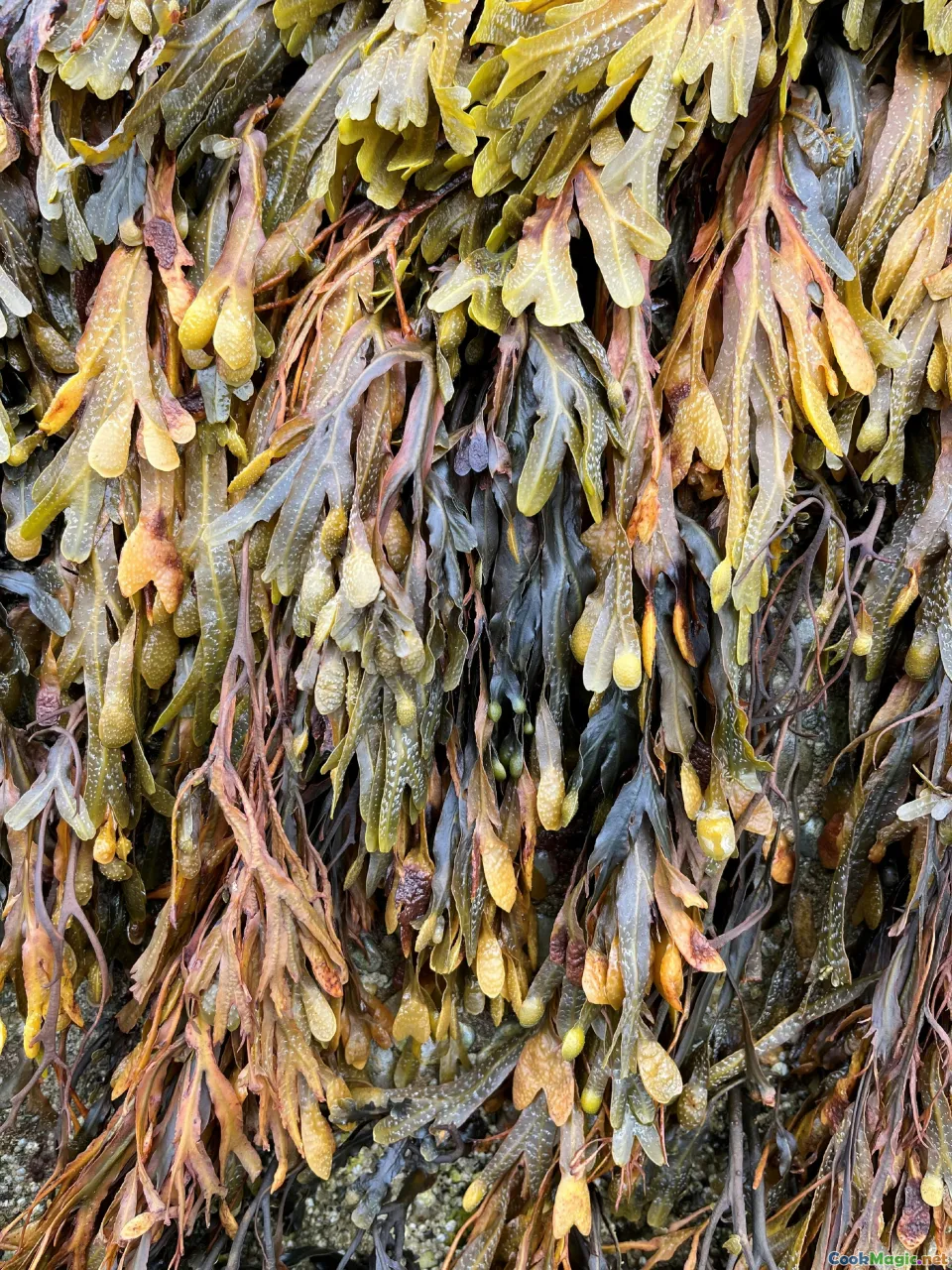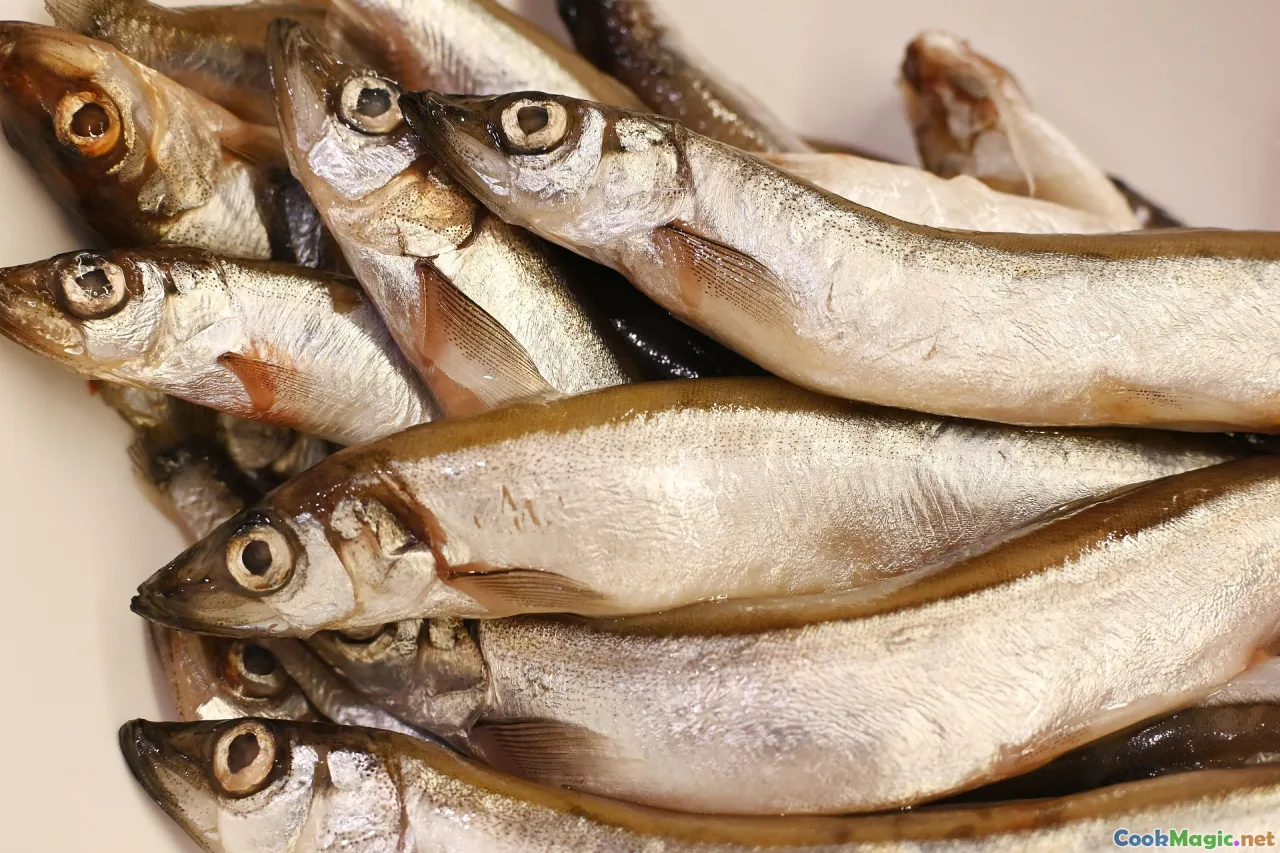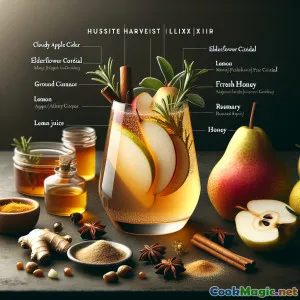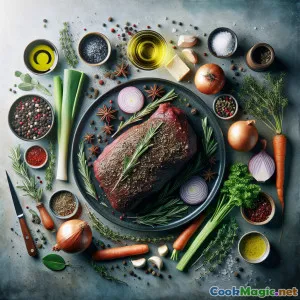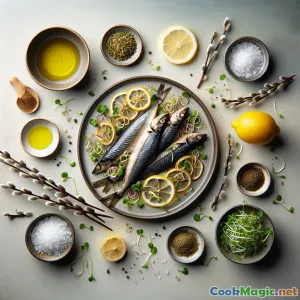
Capelín Secado al Sol con Guarnición de Rama de Sauce
(Sun-Dried Capelin with Willow Catkin Garnish)
(0 Reseñas)0
911
julio 18, 2025
Informar de un problema
Ingredientes
-
12 whole Fresca caballa
(Pez pequeño del Atlántico Norte, limpio y eviscerado)
-
20 pieces Ganchos de sauce frescos
(Recoge únicamente inflorescencias jóvenes comestibles, lejos de los arcenes y de los pesticidas.)
-
2 tbsp Sal marina
(Preferiblemente escamas de sal marina de Cornwall o Maldon.)
-
2 tbsp Aceite de oliva
(Prensado en frío para un sabor superior)
-
1 tsp Ralladura de limón
(ralladura de limón mediterráneo finamente rallada, preferentemente sin cera.)
-
0.5 tsp Pimienta negra triturada
(Molido recién para el mejor aroma)
-
20 grams microgreens
(Brotes de guisante o berro silvestre, para decorar)
-
0.25 tsp Pimentón ahumado
(Opcional, para un toque ahumado adicional)
(Pez pequeño del Atlántico Norte, limpio y eviscerado)
(Recoge únicamente inflorescencias jóvenes comestibles, lejos de los arcenes y de los pesticidas.)
(Preferiblemente escamas de sal marina de Cornwall o Maldon.)
(Prensado en frío para un sabor superior)
(ralladura de limón mediterráneo finamente rallada, preferentemente sin cera.)
(Molido recién para el mejor aroma)
(Brotes de guisante o berro silvestre, para decorar)
(Opcional, para un toque ahumado adicional)
Nutrición
- Porciones: 2
- Tamaño de porción: 1 plato (180 g)
- Calories: 328 kcal
- Carbohydrates: 7 g
- Protein: 32 g
- Fat: 18 g
- Fiber: 3 g
- Sugar: 1 g
- Sodium: 900 mg
- Cholesterol: 110 mg
- Calcium: 120 mg
- Iron: 1.9 mg
Instrucciones
-
1 - Preparar y secar al sol el capelín:
Enjuaga bien el capelín y sécalo. Frota con sal marina por dentro y por fuera. Coloca los peces sobre una rejilla expuesta al sol en un jardín bien ventilado, cubriéndolos con una malla fina o muselina para mantener alejadas a las plagas. Deja que se seque al sol durante 5-7 horas, volteándolos una vez a la mitad. El capelín debe sentirse firme, pero ligeramente maleable.
-
2 - Cosecha y preparación de las inflorescencias del sauce:
Recolecta inflorescencias de sauce jóvenes y tiernas o obténlas de fuentes de alimentos silvestres de confianza. Enjuágalas suavemente con agua fría y sécalas completamente. Recorta los tallos leñosos, conservando solo las inflorescencias suaves y peludas.
-
3 - Haz crujientes los catkins:
Calienta 1 cucharada de aceite de oliva en una sartén a fuego medio. Saltea las catkins limpias durante 5-7 minutos hasta que estén crujientes y ligeramente doradas. Retira y deja escurrir sobre papel absorbente.
-
4 - Capelín deshidratado al sol, frito en sartén:
Pincela ligeramente el capelín seco con el aceite de oliva restante. Fríelo en una sartén a fuego medio-alto durante unos 2–3 minutos por lado, hasta que esté crujiente y dorado, pero no quemado. Espolvorea ralladura de limón.
-
5 - Montar y Decorar:
Coloque el capelín crujiente en una fuente grande, cubra con una generosa porción de capullos de sauce fritos y microverdes, y espolvoree con pimienta negra (si usa pimentón ahumado). Sirva de inmediato con gajos de limón.
Enjuaga bien el capelín y sécalo. Frota con sal marina por dentro y por fuera. Coloca los peces sobre una rejilla expuesta al sol en un jardín bien ventilado, cubriéndolos con una malla fina o muselina para mantener alejadas a las plagas. Deja que se seque al sol durante 5-7 horas, volteándolos una vez a la mitad. El capelín debe sentirse firme, pero ligeramente maleable.
Recolecta inflorescencias de sauce jóvenes y tiernas o obténlas de fuentes de alimentos silvestres de confianza. Enjuágalas suavemente con agua fría y sécalas completamente. Recorta los tallos leñosos, conservando solo las inflorescencias suaves y peludas.
Calienta 1 cucharada de aceite de oliva en una sartén a fuego medio. Saltea las catkins limpias durante 5-7 minutos hasta que estén crujientes y ligeramente doradas. Retira y deja escurrir sobre papel absorbente.
Pincela ligeramente el capelín seco con el aceite de oliva restante. Fríelo en una sartén a fuego medio-alto durante unos 2–3 minutos por lado, hasta que esté crujiente y dorado, pero no quemado. Espolvorea ralladura de limón.
Coloque el capelín crujiente en una fuente grande, cubra con una generosa porción de capullos de sauce fritos y microverdes, y espolvoree con pimienta negra (si usa pimentón ahumado). Sirva de inmediato con gajos de limón.
Más información sobre: Capelín Secado al Sol con Guarnición de Rama de Sauce
Sun Dried Capelin with Willow Catkin
Summary and Inspiration
Sun Dried Capelin with Willow Catkin is a unique homage to English foraging traditions and the abundant, if underused, riches of its riversides and hedgerows. Drawing from both seabound and landbound treasures, this dish is inventive, whimsical, and true to England’s narrative of evolving gastronomy in connection with its wild landscapes.
Capelin—famously found in the cold North Atlantic and a common presence in the UK’s fisheries— is typically salted or smoked. Here, the classic sun-drying method infuses a distinctly nostalgic sense, evoking salt of the sea and rural summers. Pairing them with ephemeral spring willow catkins, on the other hand, revisits ancestral foraging customs that celebrated nature’s subtle, brief luxuries. The whole is garnished lightly with microgreens and lemon zest, placing new and wild right next to old and time-tested.
History and Cultural Significance
Historically, drying and salting small oily fish like capelin or sprats was not just practical preservation, but also a joyous feature of fairs and markets, from Yorkshire to Cornwall. Such fish were sold in bundles, sometimes toasted over coals on open air stalls. At the same time, willow branches—both majestic riverside willows and their smaller cousins— have played diverse roles across centuries: medicinal uses, crafting, shelter… and yes, food. Young willow catkins are edible and were from time-to-time eaten peasant-style: crisped, candied, or even just fresh in dire springs.
While pulling them together might seem curious, their combination tells an English tale: resourceful, wild, a touch eccentric yet deeply connected to the countryside’s rhythm.
Unique Aspects
The use of sun-dried fish echoes historical English preservation techniques but with a modern, forager's twist thanks to the willow catkin. Catkins, subtle and fleeting, add gentle crunch and visual whimsy, evoking late spring meadows.
Preparing this recipe connects the present to the past— channeling Tudor resourcefulness and Victorian curiosity for native plants. Serving it as an appetizer lets guests travel instantly to riverbanks dotted with willow trees, amid the briny closeness of the sea.
Tips & Notes
- Always confirm local regulations about foraging and eat only species you can positively identify. Never harvest from sprayed or polluted locations.
- If capelin isn't available, sprats or fresh sardines are close substitutes.
- For those cautious about wild foods, the fried catkins may be omitted or replaced with crispy seaweed or watercress.
- To sun-dry successfully in England’s fickle climate, pick the brightest, windiest days or use an oven at very low heat to finish drying.
Final Thoughts
“Sun Dried Capelin with Willow Catkin” bridges the sea and woodland, ancient preservation and wild spring foraging. Pad it out with dark rye bread and pickled onions for a fuller meal— or serve simply as an unforgettable, conversation-starting starter. However you present it, you’ll impart the sense of English countryside ingenuity— deeply rooted, yet ever-renewed— with every savory, surprising bite.


